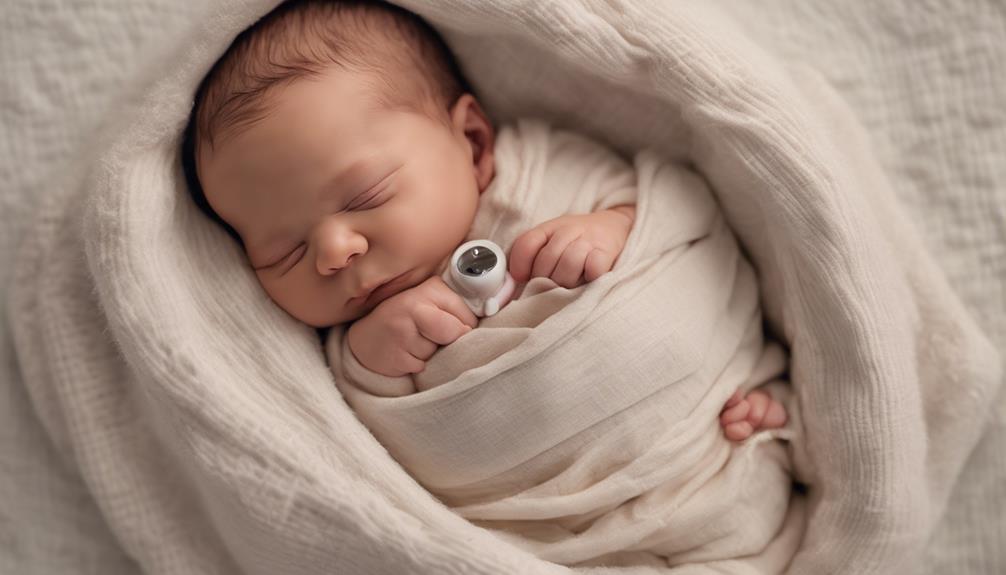Have you ever wondered if there's a foolproof way to calm your crying newborn during those sleepless nights?
Well, let's explore some practical tips that might just help you soothe your baby's cries and get some well-deserved rest.
From tried-and-true methods to innovative strategies, we'll uncover how you can navigate those challenging moments with your little one.
So, let's plunge into the world of newborn sleep cries and discover effective ways to provide comfort and peace for your baby.
Key Takeaways
- Meet newborn's basic needs promptly for comfort and well-being.
- Establish a calming sleep environment with soothing routines.
- Use movement and sound techniques to soothe and relax baby.
- Seek professional help if sleep cries persist despite soothing efforts.
Basic Needs Assessment
Evaluating the newborn's basic needs is essential when addressing their sleep cries to guarantee their comfort and well-being. When your baby is crying during sleep time, it's important to first assess if they're hungry, need a diaper change, or are tired. Ensuring these basic needs are met sets the foundation for a restful night.
Check the sleep environment to create a cozy and safe space for your little one. Make sure the room is quiet, dimly lit, and at a comfortable temperature to promote better sleep. Implementing a soothing bedtime routine can help your baby relax and get ready for bedtime. Consider techniques like swaddling or gentle rocking motions to provide comfort and calmness before sleep.
Movement and Motion

When your newborn is restless during sleep, exploring gentle movements can offer comfort and aid in soothing their cries. Rocking your baby gently can mimic the comforting motion they experienced in the womb, helping to soothe them.
Utilizing a baby swing with gentle, rhythmic movements can calm a fussy baby and promote relaxation. Taking your baby for a drive or a walk in a stroller can provide the soothing motion they need to settle down.
Using devices with vibrations, like a vibrating chair or mattress, can help calm your baby and ease their fussiness. Carrying your baby in a sling or baby carrier while moving around can provide closeness and soothing motion to help them relax.
These methods not only offer physical comfort but also foster a sense of security and closeness, creating a peaceful environment for your little one to drift off to sleep.
Comfort and Care Techniques

One effective way to provide comfort and care for your newborn during sleep cries is through swaddling, mimicking the feeling of being in the womb to promote a sense of security and comfort. Swaddling helps your baby feel snug and secure, reducing startle reflexes that can wake them up during sleep. Additionally, using white noise machines or playing gentle sounds can create a soothing environment that helps calm your baby's cries. The consistent sound can also mask other noises that might disturb their sleep. Gentle rocking or swinging motions can help relax and soothe your baby, aiding in better sleep by creating a sense of movement similar to being in the womb. Offering a pacifier or encouraging sucking can provide self-soothing comfort for your baby during sleep cries. Finally, skin-to-skin contact promotes bonding and relaxation, helping to calm both you and your baby during sleep disturbances.
| Techniques | Benefits |
|---|---|
| Swaddling | Mimics womb environment, promotes security |
| White Noise Machines | Creates soothing environment, masks disruptive sounds |
| Gentle Rocking | Relaxes and aids in better sleep |
| Pacifier | Provides self-soothing comfort |
Sound and Noise Strategies

Handling through the challenges of newborn sleep cries involves implementing sound and noise strategies that can greatly impact your baby's comfort and sleep patterns. When it comes to soothing your little one, consider the following:
- White noise: White noise machines mimic the comforting sounds of the womb, providing a familiar environment for your baby.
- Shushing: Making calming sounds can regulate your baby's breathing and heart rate, promoting relaxation and better sleep.
- Heartbeat sounds: Using a toy or device that emits heartbeat sounds can create a sense of security and familiarity, easing your baby's sleep cries.
- Humming and lullabies: Gentle humming or singing lullabies can have a calming effect on babies, helping them peacefully drift off to sleep.
- Background noise: Whether it's a fan, vacuum cleaner, or white noise app, consistent background noise can create a soothing atmosphere for your baby during sleep time.
These comforting sounds can make a significant difference in helping your newborn settle down and have a restful sleep.
Addressing Health Concerns

To address health concerns related to your newborn's sleep cries, it's important to monitor for signs of illness. Keep an eye out for symptoms like fever, unusual lethargy, changes in appetite, vomiting, diarrhea, or difficulty breathing. If you notice any of these signs, it's vital to consult a healthcare provider promptly. These symptoms could indicate underlying issues such as reflux, allergies, or other health conditions contributing to your baby's sleep disruptions.
Creating a safe sleep environment for your baby is essential in minimizing crying episodes. Guarantee the sleep space is conducive to restful sleep to help alleviate any discomfort your baby may be experiencing. If your baby's sleep cries persist despite your soothing efforts, seeking professional guidance is advisable. Professionals can offer support, advice, and medical intervention if necessary.
Frequently Asked Questions
How Do I Comfort My Baby Crying in His Sleep?
When our baby cries in their sleep, we comfort them by patting their back, offering a pacifier, ensuring a calm sleep environment, and trying white noise or gentle music. Sometimes, babies settle on their own if given a moment.
How Do You Soothe a Newborn to Sleep?
When it comes to soothing a newborn to sleep, we find that swaddling, gentle rocking, offering a pacifier, establishing a bedtime routine, and practicing skin-to-skin contact work wonders. These techniques create a cozy environment that promotes relaxation and rest.
How Can I Soothe My Screaming Newborn?
When our newborn screams, we address hunger, discomfort, or overstimulation. Gentle rocking, swaddling, and white noise create a calming space. Pacifiers, skin-to-skin contact, and rhythmic shushing help. If cries persist, we check for illness, reflux, or colic, seeking professional advice.
How Long Should I Let My Newborn Cry Before Soothing?
When our newborn cries, prioritizing responding promptly is crucial. We prioritize comforting and meeting their needs to build trust. Letting them cry for long periods can lead to stress. Quick soothing promotes attachment and emotional well-being.
Conclusion
To sum up, remember to be patient and proactive in addressing your newborn's sleep cries.
By evaluating their basic needs, utilizing movement and motion, providing comfort and care, using sound and noise strategies, and addressing any health concerns, you can soothe your baby effectively.
Stay steady, stay supportive, and stay strong in your efforts to help your little one rest peacefully.










